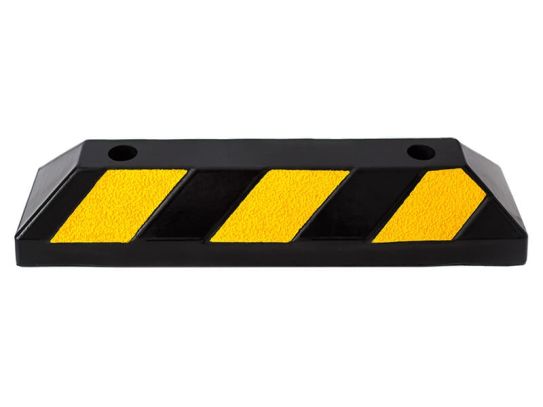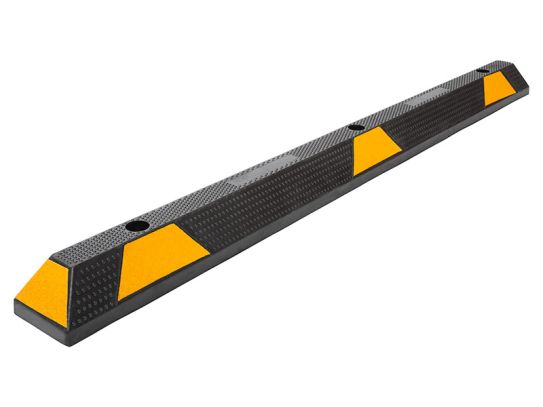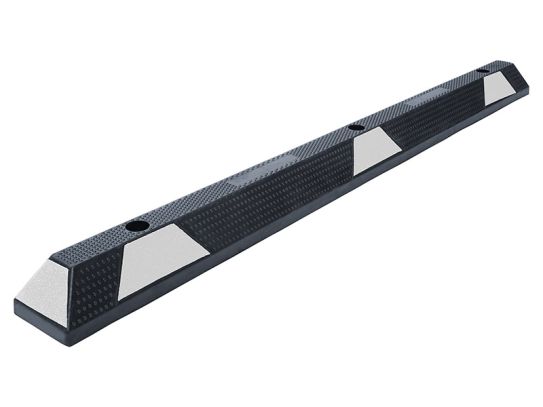Wheel Stops
Avoid Dings and Scratches with Our Easy-to-use Wheel Stops
Introducing our range of bolt down rubber wheel stops - the perfect solution for keeping your car park safe and organised.
These wheel stops are made from tough, durable rubber that can withstand heavy vehicles and won't crack or break under pressure. Plus, with their bolt down design, they're easy to install and won't shift or move, even in the most extreme weather conditions.
Not only are these wheel stops practical and reliable, they're also sleek and stylish. The bright yellow colour ensures they're highly visible, so drivers can easily spot them and know where to stop. And with a sleek, modern design, they'll add a touch of class to any car park.
What Is a Wheel Stop?
Bolt down rubber wheel stops are a simple but effective tool for ensuring the safety and organisation of car parks and other areas where vehicle traffic is present. These durable rubber blocks are secured to the ground using bolts, making them stable and sturdy. They provide a clear visual cue for drivers, indicating where cars should stop and preventing them from overshooting or parking in unauthorised areas. This helps to reduce the risk of accidents and collisions, and ensures that cars are parked in the correct areas.
How Do Wheel Stops Work?
Wheel stops are typically installed in a line along the edge of a parking space or in front of a barrier. When a car approaches the designated stopping point, the driver will see the bright yellow wheel stop and know to stop the vehicle before reaching it. This helps to prevent accidents and ensure that cars are parked in the correct area.
To install a bolt down rubber wheel stop, the ground must first be prepared by drilling holes for the bolts. The wheel stop is then placed in the desired location and the bolts are inserted through the pre-drilled holes to secure it to the ground. This ensures that the wheel stop remains in place and cannot be moved or knocked over by vehicles.
Once installed, wheel stops provide a visual cue for drivers and help to keep car parks safe and orderly. They are durable and resistant to weather, making them a reliable and long-lasting solution for car park management.
Where Are Wheel Stops Typically Used?
Wheel stops are commonly used in commercial and public car parks, as well as in residential areas. They are typically installed along the edge of parking spaces or in front of barriers, to indicate where cars should stop and prevent them from overshooting or parking in unauthorised areas.
In addition to car parks, wheel stops can also be used in other environments where vehicle traffic is present. This may include loading docks, warehouses, factories, and other industrial settings. They are also sometimes used in residential areas, to prevent cars from blocking driveways or parking in unauthorised areas.
What Are the Key Features to Consider When Choosing Wheel Stops?
When choosing wheel stops, there are several key features to consider, including:
- Size and dimensions: Wheel stops are available in a range of sizes, to accommodate different parking spaces and vehicle sizes. It is important to choose a wheel stop that is the right size for the space and the vehicles that will be using it.
- Material and durability: Wheel stops are typically made from rubber, which is durable and resistant to weather. However, different wheel stops may have different levels of durability and resistance to wear and tear. It is important to choose a wheel stop that is suitable for the environment and the type of vehicles that will be using it.
- Visibility: Wheel stops are typically bright yellow in colour, to make them highly visible to drivers. However, some wheel stops may have additional features, such as reflective strips, to increase their visibility in low-light conditions. It is important to choose a wheel stop that is visible and easy for drivers to see.
- Installation and security: Wheel stops are typically installed using bolts, which secure them to the ground. It is important to choose a wheel stop that has suitable bolt holes and is easy to install securely.
Durable Rubber Construction for Long-lasting Use
Our wheel stops are made from durable rubber, which is resistant to weather and other environmental factors. This makes them a long-lasting solution for car park management, and ensures that they remain effective and visible even in the most challenging conditions.
The rubber material used in our wheel stops is designed to withstand the weight of vehicles, as well as the effects of weather, UV radiation, and other environmental factors. It is also resistant to wear and tear, making it a durable and reliable choice for use in a wide range of environments.
High Visibility
Visibility is one of the key features of wheel stops, and is an important factor in their effectiveness. Most wheel stops are bright yellow in colour, which makes them highly visible and easy for drivers to spot. This helps to reduce the risk of accidents and collisions, and ensures that cars are parked in the correct areas.
In addition to their bright yellow colour, our wheel stops also have reflective strips on the sides, which make them even more visible at night or in low-light conditions. These reflective wheel stops are a good choice for car parks that are used at night or in areas with poor lighting, as they provide an additional layer of visibility and safety.
Safe and Secure Parking with Our Wheel Stops
Wheel stops improve the safety and organisation of a parking area by providing a visual cue for drivers, indicating where cars should stop and preventing them from overshooting or parking in unauthorised areas. This helps to reduce the risk of accidents and collisions, and ensures that cars are parked in the correct areas.
Wheel stops are also easy to install and secure, and are resistant to weather and other environmental factors. This makes them a durable and long-lasting solution for car park management, and ensures that they remain effective and visible even in the most challenging conditions.
Easy to Install for Quick and Convenient Use
Our wheel stops are easy to install and secure, making them a convenient and effective solution for car park management. They are typically installed by drilling holes in the ground and securing the wheel stop to the ground using bolts, which ensures that they remain in place and cannot be easily moved or knocked over by vehicles.
The installation process for bolt down rubber wheel stops is straightforward and does not require any special tools or equipment. The wheel stops are simply placed in the desired location, and the bolts are inserted through the pre-drilled holes and tightened securely using a wrench or other suitable tool. This ensures that the wheel stops are securely attached and cannot be easily moved or knocked over by vehicles.
How Do You Install Rubber Wheel Stops?
The process for installing bolt down wheel stops is straightforward and does not require any special tools or equipment. The steps for installing wheel stops are as follows:
- Prepare the ground: Before installing the wheel stops, it is important to prepare the ground by drilling holes for the bolts that will be used to secure the wheel stops to the ground. This ensures that the wheel stops will be securely attached and cannot be easily moved or knocked over by vehicles.
- Position the wheel stops: Once the ground is prepared, position the wheel stops in the desired location, making sure they are spaced evenly and aligned properly. This will provide a clear visual cue for drivers, indicating where cars should stop and preventing them from overshooting or parking in unauthorised areas.
- Secure the wheel stops: Once the wheel stops are in position, insert the bolts through the pre-drilled holes and tighten them securely using a wrench or other suitable tool. This ensures that the wheel stops are securely attached and cannot be easily moved or knocked over by vehicles.
- Check the wheel stops: After the wheel stops are installed, it is important to check them to make sure they are securely attached and cannot be easily moved or knocked over by vehicles. This will ensure that they are effective and will provide the desired level of safety and performance.
What Are the Best Practices for Maintaining Wheel Stops?
The best practices for maintaining rubber wheel stops include:
- Regularly inspect the wheel stops: It is important to regularly inspect the wheel stops to ensure they are in good condition and continue to perform properly. This will help to identify any issues or problems with the wheel stops, and allow them to be addressed before they become more serious or cause accidents or other issues.
- Clean the wheel stops: If necessary, clean the wheel stops using a mild detergent and water, and remove any debris or dirt that may have accumulated on them. This will help to keep the wheel stops looking clean and presentable, and will ensure that they continue to provide the desired level of visibility and safety.
- Check the bolts: It is important to check the bolts that secure the wheel stops to the ground, and tighten them if necessary to ensure they are secure. This will ensure that the wheel stops remain in place and cannot be easily moved or knocked over by vehicles.
- Replace damaged or worn wheel stops: If the wheel stops become damaged or worn, replace them immediately to ensure they continue to provide the desired level of safety and performance. This will help to prevent accidents and other issues, and will ensure that the wheel stops continue to be effective and reliable.
Are There Any UK or European Industry Standards or Regulations That Apply to Wheel Stops?
There are a number of UK and European industry standards and regulations that apply to wheel stops. These standards and regulations are designed to ensure that wheel stops are safe, effective, and suitable for use in a wide range of environments.
In the UK, wheel stops must meet the requirements of the British Standards Institution (BSI) standard BS EN 12519:2018, which specifies the requirements and test methods for wheel stops. This standard covers the design, construction, installation, and performance of wheel stops, and sets out requirements for factors such as size, materials, and visibility.
In Europe, wheel stops must also meet the requirements of the European standard EN 1436:2004, which specifies the requirements and test methods for wheel stops. This standard is similar to the UK standard, and covers the same factors such as size, materials, and visibility.


